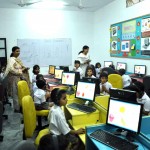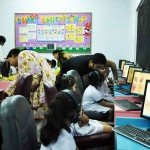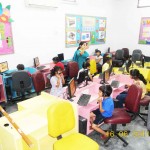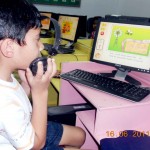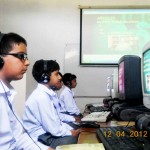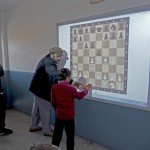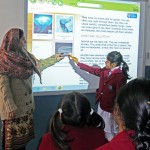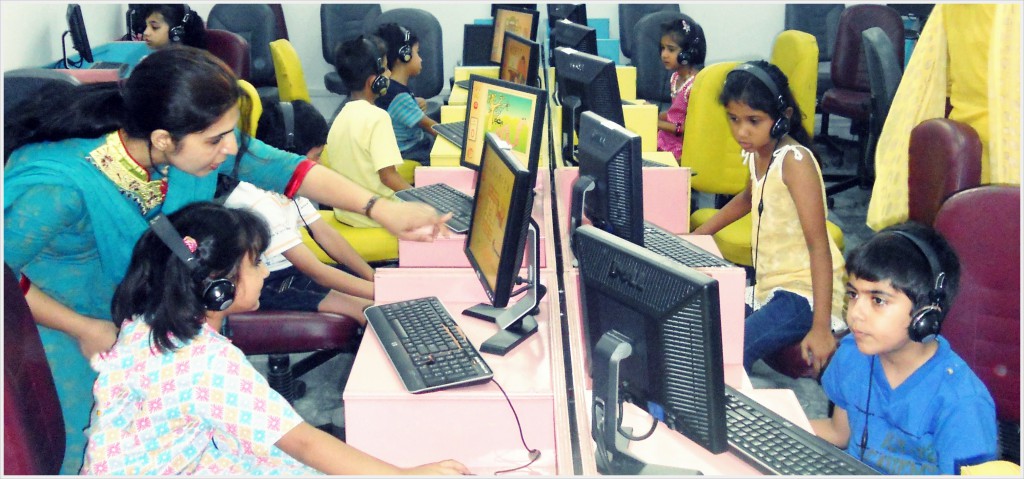 After the successful launch of the Alhamra Town Campus Smart Camp, The Laurelbank School System is proud to announce the incorporation of Smart Education in its Elementary Section. Our program includes software designed by the world renowned computer scientist Dr. Hamayun Mian (the pioneer of smart education in Pakistan) along with our IT team.
After the successful launch of the Alhamra Town Campus Smart Camp, The Laurelbank School System is proud to announce the incorporation of Smart Education in its Elementary Section. Our program includes software designed by the world renowned computer scientist Dr. Hamayun Mian (the pioneer of smart education in Pakistan) along with our IT team.
In order to understand what Smart Education really entails one must fully comprehend The word ‘Smart’. In this context The word “Smart’ comes from the rapidly developing technologies collectively termed as Artificial Intelligence and Machine Intelligence. Thus the adjective ‘Smart’ implies a computer-assisted system capable of observing, recording and using experiences to learn continuously and improve performance. A ‘Smart System’ is in reality an extension of the human system that learns, grows continuously and completely outperforms conventional human systems. Smart Systems have been developed in almost all fields of human endeavour to assist and enhance the performance of a pure human system many times over. Robotics, medical diagnosis, surgery, genetics, astrophysics are only a few examples where smart programs/systems are becoming commonplace. Thus the smart education system has been developed to improve and impart education at levels which is simply not possible just through conventional teaching.
Education is not how it used to be. Quantum leaps in technology have brought out newer teaching methods into the horizon. Like everything else, automation and artificial intelligence are replacing and enhancing the traditional student-teacher model rapidly.
The Laurelbank School System integrates education from kindergarten up to grade 5 through a specially developed intelligent software system using a new teaching methodology and artificial/machine intelligence. This methodology requires no private tutoring as it provides a dynamic learning environment which automatically tailors itself to the needs of each individual pupil. The hi-tech multi-media computer labs are fully air-conditioned, & provide individually designed stations for each student. Each pupil is monitored by the teacher and a skilled lab attendant while attempting programs which configure according to the student’s understanding level.
LSS Smart Education Classes in Progress
Genesis of Artificial Intelligence
(Dr. Hamayun M. Mian)
Introduction:
Most lay people would believe that they have already seen the roles a computer will play in the 21st century in human society. Nothing could be farther from the truth. A computer, as experienced in every day life today is in real infancy today but doubling its capabilities every 18 months or so. A computer in theory is not merely a productivity device – it is a universal machine which could ‘emulate anything’ which humans can do or perceive! Computers are fore-bearers of an entirely new Paradigm, which at present may not be perceived clearly except by theoreticians of computer science and applied mathematics. It is our purpose here first to clarify scientific essentials of the imminent computers paradigm, what is meant or expected out of this universal machine. Finally, we will attempt to present a scenario how and where will the latent power of this new machine will soon be unleashed, radically changing almost everything we see and do today; i.e. ushering a new paradigm whose parallel has never been experienced before by the human society.
Computer, the Universal Machine:
Most authorities1 on the history of computer science will agree that the original father of the ‘theory of automata’ was a Muslim mathematician/philosopher Abu-Mussa Alkhawarizmi who was born in the Persia (Khawarizm) approximately in 780 A.D. and lived and worked in Baghdad until around 850 A.D. Theory of automata is a branch of (discrete) mathematics which provides the theory for building a modern electronic computer. Just for interest of the reader, I will try to explain here the gist of what this great Muslim mathematician and thinker, Abu-Musa Alkhawarizmi proposed in early 9th century:
Like matter, all scientifically definable problems can be broken down into smaller and smaller components. Whereby the smallest identifiable component of matter is an atom, the smallest identity component of a logical problem is a ‘predicate’. Predicate is a simple proposition which can be answered either with a ‘yes’ or a ‘no’; e.g. (1)is one greater than zero? (2) Was Plato Socrates’ teacher? (3) Is Pakistan situated in Asia? Alkhawarizmi then showed that if all predicates (broken down parts) of a problem are answered one at a time, in a correct sequence, a solution to the original problem will be discovered. The break-down, sequencing and the resulting computation became popular in the middle ages as ‘Al-Khawarizmism’, which during the renaissance became corrupted and is known today to every student of science as an ‘algorithm’.
A number of individual mathematicians and scientists worked on what Alkhawarizmi postulated and finally in early 20th century two mathematicians, Allen Turing and Von Neumann, almost simultaneously came up with a conceptual design for a logic machine for solving problems mechanically. This design became popular as Turing Machine, Von Neumann machine, or a universal computing machine. A theoretical proposition of the universal computational machine is that given enough speed and capacity, the machine could emulate (mimic) any mechanism, including the human thinking process. Although this theoretical claim was put forward in the first half of the 20th century it took science and technology almost 70 years to generate enough processing power to put the truth of the statement to practical testing.
What is Artificial Intelligence (AI)?
Although possibility of giving machines artificial intelligence appeared in the first half of the 20th century, it was not until late 60’s that universities raising departments of AI and supporting research on the subject. Thus it was not until 1969 I, as a researcher and teacher of Operations Research came face to face with the subject of artificial intelligence (AI). Many authorities on AI have tried to define it in non technical terms. Some of these are as follows:
• “AI is the art of making computers do ‘smart’ things.” (Waldrop).
• “AI is the activity of providing such machines as computers with the ability to display behavior that would be regarded as intelligent if it were observed in humans.” (McLeod, R.)
Most appropriate description of AI would be as a simultaneous developments in computer technology, computational algorithms and an insight into human thinking processes. It was realized suddenly that an electronic computer could easily be programmed to imitate many aspects of human thinking process very closely. One of the greatest living mathematician/thinker, Roger Penrose gives very revealing comparisons between an electronic computer and human brain in ‘The Emperor’s New Mind’.
The Human Thinking Process in a Nutshell!
What is known today with a very high degree of certainty that the human thinking process is an electro-chemical process whose basic actors are a special type of human cells called ‘neurons’. An average human brain contains literally billion of neurons. Neuron is a tree shaped (dendrite) structures arranged inside the brain in the form of a network, in such a way that many neurons would be touching any other neuron through special sites called synapses. As soon as one or more inputs are received through the various human sensory organs (sound, vision, touch, smell, even thought/memory) it is electro-chemically conveyed to some specific sub-network of neurons for processing. This neuron network generates outputs which lead to activation of certain muscles (action) or other neurons (thought).
What is very special in human brain functions is that it receives a feed-back of the consequence of any/all of its outputs, through the animal/human preceptor system, weighs the suitability/desirability of the consequence and depending on this analysis it is capable of dynamically altering its relevant neuron/dendrite circuits in such a way that in future the new mechanism will lead to better or improved response to same and similar experiences. A very trivial everyday observation of this is an infant, who might get his /her fingers burnt by bringing it near fire a couple of times, would automatically ‘learn’ to keep away from fire. This phenomenon of self-learning or improvements is what we generally call ‘human intelligence’. More advanced and complicated examples of this mechanism could be isolated by observing a youngster learning to play tennis or chess etc.
Once the mechanism of how human intelligence or knowledge gathering system works in humans was beginning to be better understood by biologists and other scientists, it became a fascinating challenge to the computer scientists and mathematicians. They were convinced that this process can be duplicated with an amazing similarity- thus that thinking machines could be constructed to take over many functions from humans.
Using Computers as a Medium of Instruction
(Dr. Hamayun M. Mian)
1.0 An Introduction to the Imminent Paradigm Shift in the Educational Requirements and Methods for Tomorrow:
Thomas Kuhn in his classic work ‘The Structure of Scientific Revolutions’ provides an excellent insight into how every so often major scientific revolutions lead to paradigm shifts that completely alter the way human society behaves and works. He points out that the most recent scientific revolution of human society can be distinctly traced to the beginning of the twentieth century (1905), which more or less was complete by 1935. In very broad terms this revolution dealt with the very nature of matter and energy, as well as their relationship and interaction with each other. Theories of Specific & General relativity and Quantum Physics are the general terms in which this scientific revolution is identified by the society at large. The results of this revolution, as far as human society is concerned, were manifested in two major technologies i.e. (i) electronics (ii) atomic energy. The society now according to Kuhn’s theory will continue to reap the benefits as well as face potential dangers of this revolution for some time to come. Its is therefore imminent, according to Kuhn, that the way humans live and interact with each other will change in a fundamental way; as the findings of the scientific revolution are slowly converted into new technologies.
The two distinct technologies that have already surfaced so far as a consequence of the Quantum Revolution are (i) production of enormous amounts of energy through disintegration (fission) or fusion of individual atoms, (ii) production of ever-shrinking microscopic electrical circuits operating upon individual electrons or photons, making it possible to manufacture instruments and tools of an ever increasing capability through astronomical computational powers and artificially created intelligence to deal with subjects which were hitherto considered unsuitable for mechanisation/ automation!
An electronic computer is perhaps the most visible form of the quantum-physics based technologies. The astonishing developments in the computer technology over the past few decades are so evident and ubiquitous that they do not merit much discussion. In fact according to a rule coined in the sixth decade of the last century (Moore’s Law) states that the electronic computer will continue to double its power and capacity roughly every 18 months without any increase in the cost. So far the developments in electronic computers have easily surpassed the developments envisaged in the Moore’s Law; and there seems no end to this explosion of development in electronics and its sister technology e.g. photonics, single-electron technology, nanotechnology etc. Electronic devices smaller than a single atom (nano-devices less than 0.000,000,001 meters in size) are already a reality, albeit confined to physics laboratories so far.
One of the major impacts of computer related developments on human society is the emergence of an altogether new technology called Information Technology or IT. IT has rapidly become a component of every household and office of the developed world whereas the developing parts of the world are trying desperately to catch up fast. In its broadest terms, IT stands for innovative use of computers in acquiring, retaining and using of information and knowledge in various sectors of the world economy. The most important and critical component of IT is the emergence of the Internet which is a world-wide system that links over hundred million individual computers together over computer controlled digital communications system and allows easy, free and fast exchange of information and propagation of knowledge.
A detailed and comprehensive treatment of all the implications and impacts of information technology and its associated devices and methods (intra-nets, local area networks, wide area networks, Cyber-space, wireless networks, the Internet etc.) is not intended here. What must however be highlighted is that two things must become very clear related to this phenomenon i.e. (i) emergence of IT does not mean merely introduction of a new facility or technology, it dictates a complete change of paradigm of human society, thus impacting almost all fundamental aspects of human society, (ii) emergence of IT has already begun to challenge and alter the very axioms of how knowledge is acquired, retained and used by humans in the future.
An excellent and detailed treatment of the full impact and scenarios of the emergence of IT on human society is made in ‘Visions (How Science Will Revolutionize the Twenty-first Century) by Kaku, Michio, 1997. It predicts obsolescence of most of what are considered key-professions today and emergence of a completely altered set of human professions and pre-occupations. Moreover it predicts this paradigm change to take place at an ever increasing speed with major developments being completed before the end of the first two decades of the twenty-first century.
The key question that must be asked today is therefore that if all Pundits agree on this imminent and axiomatic change of human society then how one does prepare oneself for this imminent revolution? The answer to this question is by re-assessing and redesigning the classrooms and teaching methodologies of today!
Unfortunately, there is very little general awareness today of this impending requirement for altering today’s education methods in line with the requirements of tomorrow, particularly in the developing world. Worse still, even where more knowledgeable parents are realizing this change in the type of education their children must receive today to cope with tomorrow, there does not exist a choice, especially in countries like Pakistan. Even the elite and the most expensive schools in Pakistan are today providing only a partial and superficial solution to the problem by instructing the youngsters in the use of computers and perhaps acquainting them with the Internet. This is nether sufficient nor appropriate if these children are to be prepared to meet the demands of tomorrow, and that is the opportunity this project wishes to avail by devising classrooms and teaching methods designed to fulfil the needs for tomorrow.
2.0 The Opportunity:
The gap between what is being provided by the elite schools of today and what is required for tomorrow is huge but perhaps not understood or realised fully by most parents and educationists today. Thus, there exists a compulsion today to investigate the ways and means in which computers are likely to change the learning paradigm in existence today; and then to start experimenting and developing techniques and methods that may be used to gain full advantage of these emerging tools in the field of education at large and imparting of instruction in particular.
There are many ways in which a modern computer can be used to help the learning process i.e.:
By Engaging and Involving Students in the Learning Process:
An appropriately designed computer based learning programme will totally engross a student into the process as if it were a game. The result is that student begins to acquire new knowledge without even realising it. Whereas in the kindergarten students begin to learn about shapes, geometry, dimensions, colours etc.; they slowly graduate to learn the process of inquiry and methods of finding answers to these inquiries and ultimately discover the research and knowledge synthesis processes which are bases of human problem solving. Once a student learns how to acquire a required piece of knowledge/information quickly through the use of computers and the Internet, he/she is freed of prior burdening of their memory systems with vast amounts of knowledge. Thus the mind of the child develops through the path of inquiry and analysis rather than through cumbersome and difficult rote-memorisation.
Saving the Students from an early Stigma:
In a classic learning environment a single teacher is responsible for instructing a bunch of youngsters which all have their individual learning patterns and capabilities i.e. the learning curve. In principle therefore a teacher must proceed at a rate or speed which is situated somewhere halfway between the sharpest and the shallowest learning curves. This necessarily will mean that about half the class find the speed too slow while the other half too fast for their specific needs. Thus one half of the class is frustrated or bored to various degrees whereas the remaining half is daunted or overawed. The net result is that the classic learning methodology tends to create false stigmas and complexes amongst individuals from which they may never recover. The word false is used here deliberately as in many case the apparently slow learning rate would merely be a parameter of an individual psyche and such a person could in reality may turn out to be of outstanding abilities. Albert Einstein, Winston Churchill and Graham Bell are those geniuses which provide shocking examples of early stigmatization, albeit they were amongst those few lucky ones who were able to ultimately beat such early complexes. A computer as an instruction tool can be used in most cases which can allow each individual to learn according to his/her learning curve without hiding the different rates of learning of each individual and thus avoid stigmas and complexes.
Fostering the Development of Abstraction Capabilities:
Difficult and complex problems must be first reduced to simpler components before each component can be solved with relative ease, thus deriving a solution for the overall problem. This is called the process of abstraction and is essential for problem solving and decision making today. Also known as problem solving through algorithms (Al-Khawarism), computer and computer programs are excellent tools for fostering the ability for such abstraction.
Fostering the Development of Higher order Thinking Skills:
The inquiry based learning process promoted through the use of computers provides the recipients with an opportunity to develop an ability to acquire and organise complex information, recognise trends and patterns, learning the methods of collaborative efforts towards thinking and inference making. There are several research studies which show that computer-using students develop a much higher skills for critical-thinking and problem solving as compared to students in traditional classroom environment (Pogrow, 1996; Chessler, Rockman, and Walker, 1998)
Mastering of the Subject:
Learning through computers is an infinitely patient and flexible process. Every student can learn at his/her own pace, repeating and inquiring wherever required until mastery is achieved. A vast treasure of knowledge is available to the student from a host of resources, prospective and viewpoint. This introduces a level of comprehension and mastery of the subject matter seldom achieved through extant learning process. Not only does it increase comprehension level but also remarkably reduces the time to achieve the mastery.
Increased Creativity through Parsimony of Knowledge-Retention:
Modern computer based learning must focus on ability to solve very complex problems with a minimum need for burden of pre-acquired or retained knowledge. It concentrates upon quickly finding the required information thus alleviating the need for pre-possessing it. This relief on the memorisation process is often manifested in the form of increased creativity in an individual.
